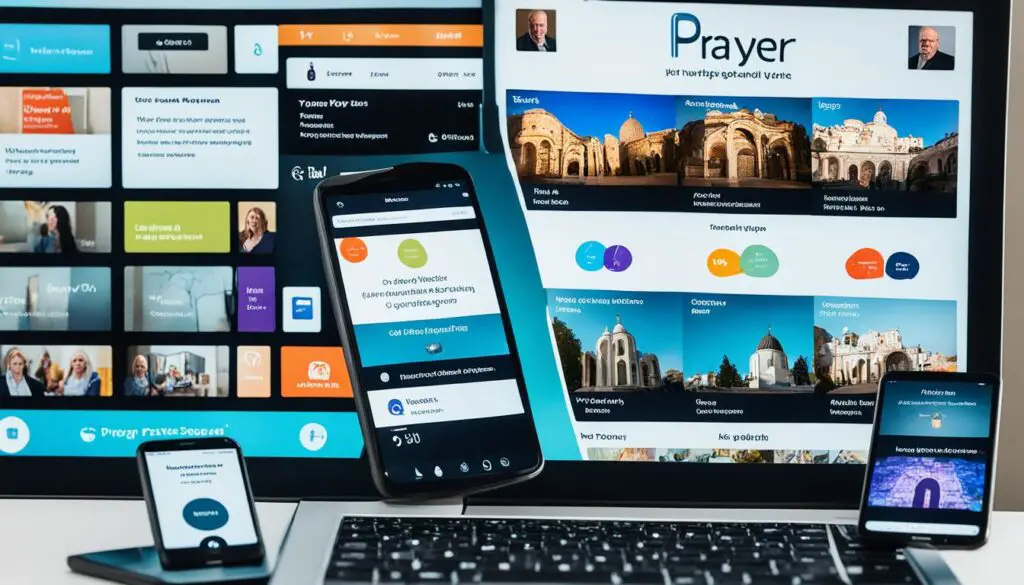Expressive prayer is an essential aspect of Christian prayer, alongside contemplative prayer. It involves voicing one’s faith, desires, and needs to God using personal words, liturgical words, or prayers composed by others. By engaging in expressive prayer, individuals can experience transformational growth on their spiritual journey.
There are various prayer techniques that can be employed to enhance one’s prayer life. Whether through unique prayer methods, creative prayer ideas, or devotional practices, the goal is to cultivate a deep and intimate connection with God. Expressive prayer encompasses different dimensions such as adoration, confession, thanksgiving, and petition, allowing individuals to express their love, seek forgiveness, offer gratitude, and present their requests to God.
In addition to expressive prayer, contemplative prayer is also vital for spiritual growth. It is a receptive form of prayer where individuals wait in silence, open and receptive to God’s presence. This prayer of loving attention helps establish a balanced and rich spiritual practice.
Key Takeaways:
- Expressive prayer involves voicing one’s faith, desires, and needs to God using personal words, liturgical words, or prayers composed by others.
- Contemplative prayer is a receptive prayer that involves waiting in silence and seeking a deep connection with God.
- Expressive prayer can be enhanced through various techniques such as adoration, confession, thanksgiving, and petition.
- Incorporating both expressive and receptive forms of prayer is essential for a balanced and rich spiritual practice.
- Embracing expressive prayer techniques can lead to spiritual growth and transformative experiences on the prayer journey.
The Dimensions of Expressive Prayer
Expressive prayer encompasses different dimensions that serve specific purposes in one’s spiritual journey. Understanding and cultivating these dimensions can lead to a balanced and intimate spirituality. Let’s explore the various dimensions of expressive prayer:
Liturgical Prayer
Liturgical prayer is a communal form of prayer performed by the entire people of God. It often takes place during community gatherings, such as the Holy Eucharist or the Daily Office. Liturgical prayer follows a structured format and incorporates specific prayers, readings, and rituals to worship and honor God collectively.
Devotional Prayer
Devotional prayer involves the recitation of prayers that are memorized or found in religious books. Examples include bedtime prayers, grace before meals, or the Rosary. These prayers provide a framework for expressing devotion, seeking guidance, and developing a deeper connection with God.
Personal Prayer
Personal prayer is an intimate conversation between an individual and God. It is a time to express love, seek forgiveness, offer petitions, and give thanks. This form of prayer allows for a personal and direct relationship with God, fostering a deep sense of connection and spiritual growth.
Meditative Prayer
Meditative prayer involves engaging the imagination and reflecting on God’s beauty, truth, and goodness. It is a contemplative practice that encourages deep reflection, silence, and stillness. Meditative prayer allows individuals to connect with God on a profound level, fostering inner peace and spiritual renewal.
Contemplative Prayer
Contemplative prayer is a grace from God, where individuals wait in silence and surrender to God’s presence. It is a prayer of pure receptivity, where one opens themselves to experience the divine. Contemplative prayer often involves practices like centering prayer or breath prayer, allowing individuals to experience God beyond words or thoughts.
Mystical Prayer
Mystical prayer is a profound and transformative state that transcends ordinary awareness. In this form of prayer, individuals may experience moments of ecstasy, purification, or conscious union with God. Mystical prayer goes beyond human understanding and can lead to profound spiritual insights and personal transformation.

By embracing and nurturing these dimensions of prayer, individuals can cultivate a holistic and enriching prayer life. Each dimension offers a unique experience and enhances the spiritual journey, leading to a deeper connection with God and personal transformation.
Tips for Effective Expressive Prayer
In order to enhance your prayer experience and cultivate an effective prayer life, consider the following practical tips:
Create a Dedicated Prayer Space
Having a dedicated prayer space that is free from distractions can provide a conducive environment for a focused and intimate conversation with God. Whether it’s a corner in your room, a quiet garden, or a prayer room, find a space where you can retreat and connect with God.
Set a Consistent Prayer Time
It is essential to set aside a consistent prayer time to prioritize prayer as a daily practice. Consider using an alarm or setting a reminder to ensure that you carve out time specifically for prayer each day. This consistency will help you establish a rhythm of prayer and deepen your connection with God.
Develop a Structured Prayer Practice
Having a structured prayer practice can provide guidance and intentionality to your prayer life. Consider using specific prayer points, engaging in a focused meditation, or maintaining a prayer journal to record your thoughts and reflections. This structure will help you stay grounded and centered in your prayers.
Pray with Music
Add a touch of musicality to your prayer time by incorporating worship songs or creating a personalized playlist. Music has a unique ability to set the mood, stir emotions, and enhance your prayer experience. Allow the melodies and lyrics to become a medium through which you express your heart to God.
Adopt a Proper Prayer Posture
Your physical posture while praying can significantly impact the depth and focus of your prayers. Whether you choose to stand, sit upright, or even walk during your prayer time, find a posture that helps you enter into a deeper communion with God. Experiment with different postures and discover what works best for you.
Find a Prayer Partner
Having a prayer partner can provide mutual support and accountability in your prayer journey. Joining hands with someone who shares your desire for a vibrant prayer life can foster growth and encouragement. Together, you can pray, share insights, and uplift each other on the spiritual path.
“Prayer is not asking. It is a longing of the soul. It is daily admission of one’s weakness. It is better in prayer to have a heart without words than words without a heart.” – Mahatma Gandhi

| Benefits of Effective Expressive Prayer | Tips for an Effective Prayer Life |
|---|---|
| Deepens spiritual connection | Create a dedicated prayer space |
| Nurtures personal transformation | Set a consistent prayer time |
| Fosters intimacy with God | Develop a structured prayer practice |
| Brings peace and clarity | Pray with music |
| Strengthens faith | Adopt a proper prayer posture |
| Builds community and support | Find a prayer partner |
Maintaining an Effective Prayer Life
Maintaining an effective prayer life requires discipline and commitment. To ensure that prayer remains a priority, it is essential to establish a sense of discipline and eliminate distractions that may hinder the prayer experience. By making prayer a daily habit, individuals can cultivate a deeper connection with God and experience spiritual growth.
One effective way to maintain discipline is by having accountability through a prayer partner or mentor. This accountability helps individuals stay motivated and committed to their prayer journey. It provides a support system where individuals can share their challenges, seek guidance, and celebrate their progress together.
Another valuable resource for maintaining an effective prayer life is utilizing online prayer resources. These resources, such as live prayer sessions or sermons, provide guidance, inspiration, and a sense of community even in virtual spaces. Online prayer resources offer convenience and accessibility, allowing individuals to connect with a larger prayer community and engage in meaningful prayer experiences.
In addition to online resources, having physical prayer materials can also contribute to a deeper prayer life. Books or novels that emphasize the importance of prayer serve as reminders and tools for enhancing one’s prayer practice. They provide insights, wisdom, and new perspectives that can inspire individuals in their journey of prayer.
Furthermore, being an active part of a local church community that values prayer is essential for maintaining an effective prayer life. Participating in communal worship, prayer meetings, and spiritual growth activities within the local church allows individuals to engage in collective prayer experiences while benefiting from the support and encouragement of fellow believers.
Maintaining an effective prayer life requires:
| Discipline | Accountability | Mentorship | Online Prayer Resources | Prayer Materials | Local Church Community |
|---|---|---|---|---|---|
| Eliminating distractions and prioritizing prayer | Having a prayer partner or mentor for support | Utilizing online prayer resources for guidance and inspiration | Engaging with books or novels that emphasize prayer | Being part of a church community that values prayer | Participating in communal worship and spiritual growth activities |
By incorporating these practices into one’s daily life, individuals can maintain an effective prayer life and continue to deepen their relationship with God.

Conclusion
Expressive prayer techniques serve as powerful tools for fostering spiritual growth and experiencing personal transformation. By incorporating various dimensions of prayer, such as liturgical, devotional, personal, meditative, and contemplative prayer, individuals can establish a deep and intimate connection with their spirituality.
Adopting effective prayer practices plays a crucial role in enhancing the prayer journey. Creating a dedicated prayer space, setting consistent prayer times, using structured prayer methods, and praying with music can contribute to a more profound and fulfilling prayer experience. Additionally, adopting proper prayer postures and having accountability through prayer partners can further enrich the transformative power of expressive prayer.
To maintain an effective prayer life, discipline, accountability, mentorship, access to prayer resources, and active participation in a local church community are vital. By following these practices and fully embracing the potential of expressive prayer, individuals can embark on a transformative prayer journey and facilitate profound spiritual growth in their lives.
By integrating expressive prayer techniques into their daily lives, individuals can experience a more profound sense of connection with God and find the inspiration and guidance needed to navigate life’s challenges. The transformative power of prayer is within everyone’s grasp, offering a remarkable avenue for personal growth, spiritual enlightenment, and a deeper understanding of the divine.
FAQ
What is expressive prayer?
Expressive prayer is a form of Christian prayer where individuals voice their faith, desires, and needs to God using personal words, liturgical words, or prayers composed by others.
What are the main types of expressive prayer?
The main types of expressive prayer are adoration, confession, thanksgiving, and petition.
What is contemplative prayer?
Contemplative prayer is a receptive prayer where individuals wait in silence and surrender to God’s presence, seeking a deep connection with Him.
What are the dimensions of expressive prayer?
The dimensions of expressive prayer include liturgical prayer, devotional prayer, personal prayer, meditative prayer, contemplative prayer, and mystical prayer.
How can I make my expressive prayer more effective?
To make your expressive prayer more effective, create a dedicated prayer space, set consistent prayer times, use structured prayer, pray with music, adopt proper prayer postures, and have accountability through a prayer partner.
How can I maintain an effective prayer life?
To maintain an effective prayer life, practice discipline, seek accountability, find mentorship, utilize online prayer resources, have prayer materials, and actively participate in a local church community.
How can expressive prayer techniques contribute to spiritual growth?
By incorporating different dimensions of prayer and following effective prayer practices, individuals can cultivate a rich and intimate spirituality, leading to profound spiritual growth and personal transformation.









